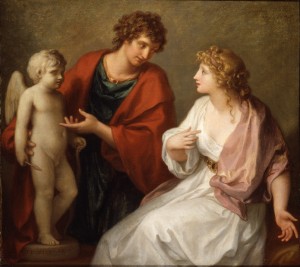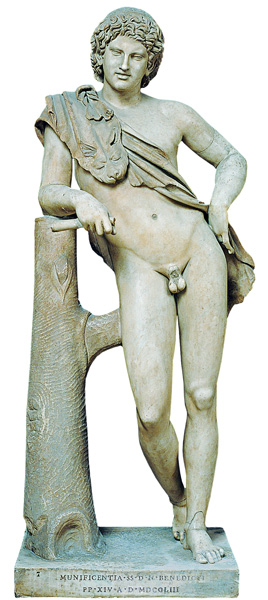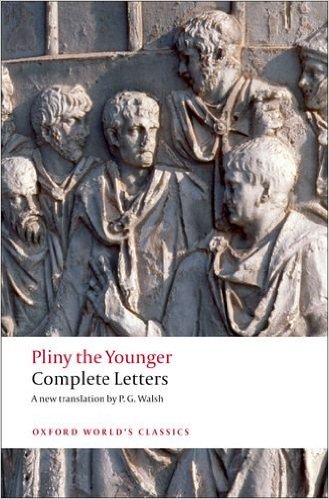
Praxiteles Giving Phryne his Statue of Cupid by Angelica Kauffmann, 1794; image source RISD Museum, distributed under a CC BY-NC-SA 3.0 license.
Before Rodin, Bernini, Michelangelo and Donatello, there was Praxiteles. He was a native of Athens, who learned the art of sculpture from his close relative Kephisodotos, and flourished in the middle part of the fourth century BC. Ancient writers rank him together with Lysippos and Scopas as one of the three great sculptors of the late classical period.
The nude statue of the Aphrodite of Cnidus has been considered Praxiteles’ masterpiece from ancient times [1]. He is alleged to have used his lover, the famed courtesan Phryne [2], as a model for the statue. It holds a special place in art history as the first-ever nude female sculpture not regarded to be profane. The thing is praised like crazy by Pliny the Elder, who went so far as to proclaim it the finest statue in all the world [3]. And legend has it that the statue was of such exquisite beauty that one man even tried to have sex with it [4]. Only bits and pieces remain of the original figure, but if the surviving Roman imitations and literary descriptions are any indication, then it must have been a work of considerable artistic merit.
It is surprising, then, to find that Praxiteles did not himself consider the Aphrodite of Cnidus to be his masterpiece; that is, if a possibly apocryphal story related by Pausanias is to be believed. He writes in his description of Attica [5,6]:
Once when Phryne asked what was his (Praxiteles’) most beautiful work, he promised like a true lover to give it to her but refused to say which he thought it was. So a servant of Phryne’s came rushing in and told him his house was on fire and most of his work was lost. Praxiteles rushed out of the doors exclaiming that if the fire had got at the Satyr and the Eros (Cupid) then he had worked for nothing. Phryne told him he could put his mind at rest, nothing horrible had happened except that he was trapped into admitting which was his masterpiece. So Phryne chose Eros, and Dionysos in the temple close by has had the Satyr boy to offer him a drink; Eros standing beside him and Dionysos are by Thymilos.
Praxiteles had a reputation in antiquity for playing coy. Pliny the Elder records that whenever Praxiteles was asked which of his own works in marble he most adored, he would reply, ‘the ones which Nicias has set his hand’ [7]. Nicias was an Athenian painter renown for his ability to depict the female figure in dramatic situations. It is oblique answers of this kind by Praxiteles that evidently disposed Phryne to resort to the cunning appeal to his gullibility related above.

An imitation of Praxiteles’ Leaning Satyr by an unknown Roman sculptor, circa 130 AD. It stands 170 cm tall. The penis has been knocked off. Image source: Musei Capitolini.
As with Praxiteles’ Aphrodite of Cindus, his Leaning Satyr and Eros of Thespiae have all but perished. The loss of these masterpieces is lamentable, but the overall loss to civilisation that has resulted is not so great as might be supposed. This is because the statues survived long enough — Praxiteles’ initial fear that they were destroyed by fire being unfounded — for imitations to have been produced across the Greco-Roman world. The surviving imitations are imperfect from an information theoretical point of view. It is not for the artist to play the role of error-correcting code in the noisy channel of communication that is sculpture. On the contrary, each imitation stands as its own work of art in so far as it reflects the style are temperament of the nameless artist who produced it. In spite of all these delightful ‘errors’, the spirit, or information content, of Praxiteles’s original is nevertheless transmitted by these Roman copies in some average sense. So in this most important respect, Praxiteles’ masterpieces have survived, just with a little noise.
References (under construction)
[1] The Art of Praxiteles: The Mature Years by Antonio Corso (2007). Read it on Google Books.
[2] Making Silence Speak: Women’s Voices in Greek Literature and Society edited by André Lardinois and Laura McClure (2001), Princeton University Press. Read this passage about Praxiteles’ masterpiece at Amazon. Read a passage concerning Phryne at Google Books.
[3] Natural History by Pliny the Elder, Book 35.20-21.
[4] Erotes by pseudo-Lucian; translated by Andrew Calimach (2013). Download the pdf here.
[5] Pausanias Guide to Greece 1: Central Greece translated by Peter Levi (1984), Penguin Classics, Book I, Chapter 25, Sections 5-6.
[6] Pausanias Description of Greece translated by William Henry Samuel Jones and Henry Ardene Ormerod (1918), Harvard University Press, Book I, Chapter 20, Sections 1-2. Read this passage about Praxiteles’ masterpiece at The Perseus Digital Library.
[7] Natural History by Pliny the Elder, Book 35.130-131.

